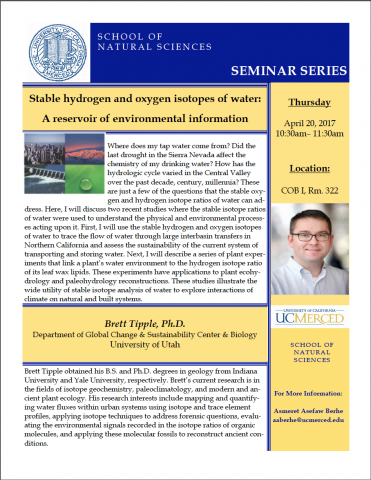
Brett Tipple, Ph.D.
Department of Global Change & Sustainability Center & Biology
University of Utah
Stable hydrogen and oxygen isotopes of water: A reservoir of environmental information
ABSTRACT
Where does my tap water come from? Did the last drought in the Sierra Nevada affect the chemistry of my drinking water? How has the hydrologic cycle varied in the Central Valley over the past decade, century, and millennia? These are just a few of the questions that the stable oxygen and hydrogen isotope ratios of water can address. Here, I will discuss two recent studies where the stable isotope ratios of water were used to understand the physical and environmental processes acting upon it. First, I will use the stable hydrogen and oxygen isotopes of water to trace the flow of water through large interbasin transfers in Northern California and assess the sustainability of the current system of transporting and storing water. Next, I will describe a series of plant experiments that link a plant's water environment to the hydrogen isotope ratio of its leaf wax lipids. These experiments have applications to plant ecohydrology and paleohydrology reconstructions. These studies illustrate the wide utility of stable isotope analysis of water to explore interactions of climate on natural and built systems.
BIOGRAPHY
Brett Tipple obtained his B.S. and Ph.D. degrees in geology from Indiana Universty and Yale University, respectively. Brett's current research is in the fields of isotope geochemistry, paleoclimatology, and modenr and ancient plant ecology. His research interests include mapping and quantifying water fluxes within urban systems using isotope and trace element profiles, applying isotope techniques to address forensic questions, evaluating the environmental signals recorded in the isotope ratios of organic molecules, and applying these molecualr fossils to reconstruct ancient conditions.



